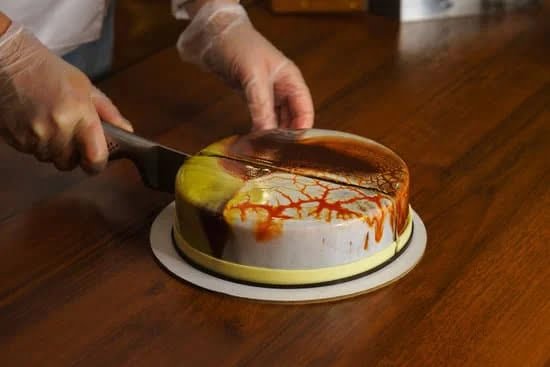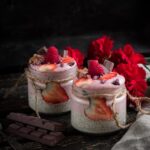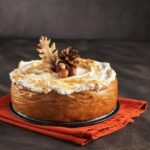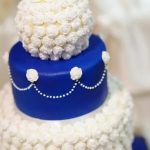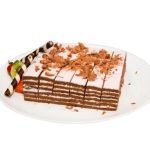When it comes to decorating cakes, the frosting plays a crucial role in both taste and appearance. While many types of frosting exist, one that stands out for its light and fluffy texture is whipped cream.
Whipped cream frosting offers a delightful taste and a soft, airy consistency that makes it perfect for creating stunning designs on cakes. Whether you’re a professional baker or just someone who enjoys making beautiful desserts, understanding the benefits of using whipped cream frosting can elevate your cake decorating skills to new heights.
Whipped cream frosting differs from traditional buttercream in various ways. Buttercream is made primarily with butter and powdered sugar, resulting in a rich and dense texture. On the other hand, whipped cream frosting combines heavy cream with powdered sugar to create a lighter and fluffier consistency. This unique characteristic allows the whipped cream frosting to be easily shaped into intricate designs while adding an extra level of elegance to any cake.
Using whipped cream for cake decoration offers several advantages over other types of frostings. Firstly, its lightness allows for easy piping and smooth application onto the cake’s surface without weighing it down. Secondly, whipped cream adds a subtle sweetness that complements any flavor combination, enhancing the overall taste experience.
Additionally, it provides a refreshing option for those looking for a lighter alternative to traditional buttercream frostings. With its versatility and ability to hold shape beautifully, whipped cream frosting is becoming increasingly popular among bakers looking to create visually appealing cakes.
In the following sections of this article series, we will delve deeper into understanding whipped cream frosting and explore how it can transform your cake decorating endeavors. From learning how to make this luscious frosting from scratch to discovering various flavors and colors you can experiment with, this comprehensive guide will equip you with everything you need to know about using whipped cream for decorating cakes. So let’s dive right in and discover the world of creativity that awaits.
The Basics
Whipped cream frosting and buttercream frosting are two popular choices when it comes to decorating cakes. While both frostings have their merits, it is important to understand the differences between them in order to make the best choice for your cake decoration needs.
One main difference between whipped cream frosting and buttercream frosting lies in their ingredients. Whipped cream frosting primarily consists of heavy cream, sugar, and vanilla extract. On the other hand, buttercream frosting is made from butter, powdered sugar, and often includes milk or cream for a smoother texture. Because of these ingredient variations, the taste and texture of each frosting differ as well.
While buttercream frosting has a rich and creamy consistency, whipped cream frosting has a light and airy texture. This makes whipped cream especially suitable for those looking for a lighter alternative that isn’t too sweet or heavy on the palate.
Furthermore, whipped cream frosting tends to be less stable compared to buttercream frosting due to its higher moisture content. This means that whipped cream may not hold up as well in warmer temperatures or under certain decorating techniques that require more stability. However, with proper reinforcement such as chilling the cake beforehand or using stabilizers like gelatin or cornstarch, it is possible to achieve a more stable whipped cream frosting.
In summary, the choice between buttercream and whipped cream frostings depends on personal preference and the specific requirements of your cake decoration project. If you prefer a lighter and less sweet option with an airy texture, then whipped cream frosting would be an excellent choice. However, if stability is a priority or if you desire a richer flavor profile for your cake decorations, then buttercream may be more suitable.
The Advantages of Using Whipped Cream for Cake Decoration
Whipped cream frosting is a popular choice for cake decoration due to its numerous advantages. First and foremost, whipped cream has a light and fluffy texture that adds an airy and delicate touch to any cake. This makes it especially suitable for decorating light and spongy cakes, as it complements their texture without overpowering them. The smooth consistency of whipped cream also allows for easy spreading and piping, making it a versatile frosting option for both beginner and experienced bakers.
One of the main advantages of using whipped cream for cake decoration is its taste. Unlike buttercream frosting, which can be overly sweet and heavy, whipped cream provides a light and refreshing flavor that pairs well with a variety of cake flavors. Its subtle sweetness enhances the natural flavors of the cake without overwhelming the palate.
In addition to its taste, another advantage of using whipped cream for decorating cakes is its ability to hold shape. While it may not have the same stability as buttercream, proper stabilization techniques can be used to ensure that the whipped cream maintains its form. By adding ingredients such as gelatin or powdered sugar stabilizers, decorators can achieve a more stable whipped cream frosting that holds up well during transportation or warm climates.
By choosing whipped cream as your go-to frosting for cake decorating, you can enjoy its many advantages, including its light and fluffy texture, delicious taste, and ability to hold shape with proper stabilization techniques. Whether you are decorating a simple birthday cake or an elaborate wedding creation, whipped cream frosting offers versatility and delightful results that will impress both visually and on the palate.
| Advantages | Description |
|---|---|
| Light and fluffy texture | Whipped cream adds an airy and delicate touch to cakes. |
| Refreshing taste | Whipped cream provides a light and subtle sweetness that enhances the natural flavors of the cake. |
| Versatile for spreading and piping | The smooth consistency of whipped cream allows for easy decorating techniques. |
| Holds shape with proper stabilization | Addition of ingredients like gelatin or powdered sugar stabilizers ensures stability for transportation or warm climates. |
Step-by-Step Guide
Gathering Ingredients and Equipment
Before you begin making whipped cream frosting from scratch, it is important to gather all the necessary ingredients and equipment. For this recipe, you will need heavy whipping cream, powdered sugar, vanilla extract (or any other desired flavoring), a mixing bowl, and an electric mixer. It is also recommended to chill the mixing bowl and beaters in the refrigerator for about 15 minutes prior to starting.
Preparing the Whipped Cream Frosting
- Start by pouring the chilled heavy whipping cream into the chilled mixing bowl. The amount of cream needed will depend on how much frosting you want to make for your cake.
- Begin whisking the cream on low speed using an electric mixer until it starts to thicken slightly.
- Increase the speed gradually to medium-high and continue whisking until soft peaks form. Soft peaks are reached when the whipped cream holds its shape but gently droops when the beaters are lifted.
- Add powdered sugar gradually, a tablespoon at a time, while continuing to whisk on medium-high speed. This will sweeten the whipped cream and stabilize it further.
- Finally, add vanilla extract or any other desired flavorings such as cocoa powder or fruit extracts. Continue whisking until stiff peaks form. Stiff peaks are achieved when the whipped cream holds its shape firmly without drooping.
Using Whipped Cream Frosting for Cake Decoration
Once your whipped cream frosting is ready, you can use it right away for decorating your cake. Here are a few tips for using whipped cream frosting effectively:
- Fill a piping bag with your whipped cream frosting and attach your desired piping tip for creating different designs and patterns on your cake.
- Gently squeeze the piping bag to release a controlled amount of frosting while moving your hand smoothly across the surface of the cake.
- Experiment with different piping tips and techniques to achieve various decorative effects such as rosettes, ruffles, or simple borders.
- If you want to add more color to your decorations, consider using food coloring gels specifically made for whipped cream. Add a small amount of the desired color to your frosting and gently fold it in until evenly blended. Avoid adding too much liquid-based food coloring as it may cause the whipped cream to deflate.
By following these steps, you can easily make whipped cream frosting from scratch and use it to create beautiful and delicious decorations for your cakes. The light and fluffy texture of the whipped cream combined with its smooth taste will surely impress your guests and satisfy their sweet tooth.
Tips and Tricks for Perfectly Decorating Cakes with Whipped Cream Frosting
Whipped cream frosting adds a light and airy touch to any cake, making it a popular choice for decorators. However, working with whipped cream can be tricky as it easily deflates or loses its shape. To help you achieve perfectly decorated cakes with whipped cream frosting, here are some tips and tricks to keep in mind.
Firstly, it’s important to start with chilled equipment. Chill the mixing bowl and whisk attachment of your mixer in the refrigerator for about 15 minutes before whipping the cream. This will help maintain a colder environment, allowing the whipped cream to hold its shape better.
When whipping the cream, use heavy cream or whipping cream that contains at least 35% milk fat. This higher fat content ensures stability and gives a richer flavor to the frosting. Avoid using light whipping creams or half-and-half, as they have lower fat content and may not whip properly.
To stabilize your whipped cream frosting and prevent it from deflating, consider adding a stabilizer such as gelatin or powdered sugar. Gelatin helps to maintain the structure of the whipped cream while powdered sugar provides additional stability due to its cornstarch content.
Another helpful tip is to gradually add your powdered sugar or sweetener of choice while whipping the cream. This allows for better incorporation and avoids over-whipping, which could lead to grainy texture or curdling of the cream.
When it comes to decorating cakes with whipped cream frosting, ensure that you have a smooth and even base layer of frosting before adding any decorations. A crumb coat helps seal in any loose crumbs and provides a clean canvas for piping designs or adding other decorative elements.
Lastly, when storing cakes decorated with whipped cream frosting, keep them refrigerated until serving time. Whipped cream is perishable and can quickly lose its shape at room temperature. If possible, avoid leaving the cake out for too long before consumption to maintain its freshness.
By following these tips and tricks, you’ll be able to create beautifully decorated cakes using whipped cream frosting. With practice and experimentation, you can explore various techniques and designs to make stunning creations that will impress your friends and family.
Whipped Cream Frosting Variations
Whipped cream frosting is not only delicious and versatile, but it also allows for endless possibilities when it comes to flavors and colors. By exploring different variations of whipped cream frosting, you can add even more creativity and uniqueness to your cake decorations.
One of the biggest advantages of using whipped cream for cake decoration is its ability to easily incorporate various flavors. By simply adding extracts or flavorings to the whipped cream, you can create a wide range of tastes. For instance, if you want to create a classic vanilla whipped cream frosting, simply add some vanilla extract or vanilla bean paste.
To make it even more exciting, consider experimenting with other extracts such as almond, mint, or coconut. These variations can elevate the taste of your cake and complement the flavors of the other components.
In addition to flavors, whipped cream frosting also allows for a variety of colors to match any occasion or theme. From pastel tones for baby showers to vibrant shades for birthdays, you can easily achieve your desired color by using food coloring or natural colorants like fruit purees.
Add a few drops at a time and mix until you achieve the desired hue. Keep in mind that using gel food coloring often produces vibrant results without affecting the consistency of the whipped cream.
By exploring different flavors and colors with whipped cream frosting, you have the opportunity to let your creativity shine through your cake decorations. Whether it’s incorporating unique flavor combinations or matching specific color palettes for events, these variations will take your cakes to the next level visually and taste-wise. The possibilities are endless when it comes to creating stunning designs that truly stand out with whipped cream frosting.
Creative Decorating Ideas
Whipped cream frosting is not only delicious, but it also offers endless possibilities for creating stunning designs on cakes. Whether you are a beginner or an experienced cake decorator, using whipped cream frosting opens up a world of creative opportunities that are sure to impress your family and friends. In this section, we will explore some creative decorating ideas that can be achieved with whipped cream frosting.
- Piping Designs: One of the simplest and most effective ways to create stunning designs with whipped cream frosting is through piping. You can use different piping tips to create various patterns such as rosettes, stars, shells, and borders. Experiment with different techniques and combine them to create unique designs.
- Ombre Effect: The ombre effect is a popular technique in cake decorating that can be easily achieved with whipped cream frosting. Start by dividing your frosting into different bowls and gradually add food coloring to each bowl to create varying shades of color. Then, using an offset spatula or a piping bag, apply the different shades of frosting onto the cake in a gradient pattern.
- Textured Designs: Whipped cream frosting also lends itself well to creating textured designs on cakes. You can use tools such as combs, brushes, or stencils to create interesting textures like basketweave, wood grain, or even marble effects. By experimenting with different tools and techniques, you can add depth and visual interest to your cake decoration.
These are just a few examples of the many creative possibilities when using whipped cream frosting for decorating cakes. Feel free to let your imagination run wild and explore other decorative techniques such as ruffles, lace patterns, or even three-dimensional designs. Remember to practice and experiment with different ideas until you find the ones that work best for you. With time and effort, you will be able to create stunning and unique cake designs that will leave everyone impressed.
Common Mistakes to Avoid When Decorating Cakes with Whipped Cream Frosting
Decorating cakes with whipped cream frosting can be a delightful and satisfying experience, but it’s important to be aware of some common mistakes that can occur. These mistakes can lead to the frosting not setting properly, the design not holding up, or a less than desired overall result. By understanding and avoiding these pitfalls, you can ensure that your cake turns out beautifully every time.
One common mistake when using whipped cream frosting is overbeating the cream. While it is necessary to beat the cream until stiff peaks form, it is crucial not to go beyond that point. Overbeating can cause the cream to become too thick and butter-like, resulting in a heavy and greasy texture. It is important to keep a close eye on the consistency of the whipped cream while beating and stop as soon as stiff peaks are achieved.
Another mistake to avoid is adding liquid ingredients or flavorings that have a high water content directly into the whipped cream. This includes extracts such as lemon juice or alcohol-based flavors like vanilla extract. The high water content in these liquids can cause the whipped cream to separate or become runny. To incorporate these flavors into your whipped cream frosting, it is best to add them gradually while whipping, ensuring that they are fully incorporated before stopping.
Additionally, one should always make sure that the cake layers are completely cooled before applying whipped cream frosting. Heat from warm cake layers can cause the frosting to melt, making it difficult for any designs or decorations to hold their shape. It’s best practice to allow at least an hour for the cake layers to cool completely before proceeding with decorating.
By avoiding these common mistakes when decorating cakes with whipped cream frosting, you will ensure a smooth and successful decorating process. Remember not to overbeat the whipped cream, be careful when incorporating liquid ingredients, and wait until your cake layers are completely cooled before applying any decorations. With these tips in mind, you’ll be able to achieve picture-perfect results with your whipped cream frosting every time.
Frequently Asked Questions
Can whipped cream frosting be used in advance?
One common concern when it comes to using whipped cream frosting for cake decoration is whether or not it can be prepared in advance. The answer to this question largely depends on the specific recipe and the conditions in which the cake will be stored.
Whipped cream is generally best when served fresh, as it tends to soften and lose its structure over time. However, there are ways to make whipped cream frosting ahead of time and still achieve good results.
If you need to prepare the frosting in advance, it is important to stabilize it to help maintain its texture and prevent it from wilting. This can be done by incorporating stabilizing agents such as gelatin or powdered sugar into the whipped cream mixture. Additionally, storing the frosted cake in a cool environment, such as a refrigerator, will help prolong the stability of the whipped cream frosting.
Is whipped cream frosting suitable for all types of cakes?
Whipped cream frosting is incredibly versatile and can be used to decorate a wide variety of cakes. Its light and fluffy texture pairs well with many different flavors and textures, making it a popular choice among bakers and dessert enthusiasts.
However, there are some considerations to keep in mind when choosing whipped cream frosting for your cake. Whipped cream frosting works best on cakes that are light and airy, such as sponge cakes or chiffon cakes. It may not hold up as well on denser cakes or those that have a lot of moisture, as it can cause the frosting to become soggy or melt more quickly.
Ultimately, it is important to consider the specific qualities of your cake when deciding whether or not whipped cream frosting is suitable. If you’re unsure, you can always test a small amount on a slice of cake before committing to using it for decorating the entire cake.
How long does whipped cream frosting hold its shape?
The stability of whipped cream frosting is one of the top concerns for decorators, as it can soften and lose its shape if not properly prepared. The length of time that whipped cream frosting holds its shape largely depends on the recipe and any stabilizing agents that are used.
On average, whipped cream frosting will hold its shape for several hours when kept in a cool environment such as a refrigerator. However, it may begin to sag or melt if left at room temperature for an extended period of time. It is important to consider the specific conditions in which the cake will be displayed or served to ensure that the whipped cream frosting maintains its desired shape.
To enhance the stability of whipped cream frosting, there are several techniques that can be employed. One method is to incorporate gelatin into the mixture, which helps to firm up the frosting and prevent it from wilting. Another option is to use powdered sugar, which acts as a stabilizer by absorbing excess moisture.
By implementing these stabilization techniques and being mindful of storage conditions, you can help ensure that your whipped cream frosting holds its shape beautifully throughout your cake decorating process and presentation.
Conclusion
In conclusion, using whipped cream frosting for cake decoration offers a multitude of advantages that make it a popular choice among bakers and dessert enthusiasts. Not only does it provide a light and fluffy texture, but it also adds an indulgent and creamy taste to your cakes. The versatility of whipped cream frosting allows for endless possibilities in terms of flavors, colors, and creative designs.
One of the main advantages of using whipped cream frosting is its ability to complement any type of cake. Whether you’re working with a classic vanilla sponge, a rich chocolate cake, or even a fruity creation, whipped cream frosting can be easily adapted to enhance the flavors and textures of each individual cake. Its lightness also prevents it from overpowering the taste of the cake itself, ensuring a balanced and delightful eating experience for everyone.
Furthermore, whipped cream frosting provides an excellent canvas for creative designs and decorations. Its smooth and airy consistency makes it easy to pipe intricate patterns, create elegant rosettes or swirls, or even sculpt whimsical shapes on top of your cakes. With some practice and experimentation, you can transform simple cakes into stunning masterpieces that are not only visually appealing but also delectable.
Overall, using whipped cream frosting for cake decoration is a wonderful choice that can elevate your baking skills to new heights. Whether you’re a professional pastry chef or an amateur baker looking to impress your friends and family, whipped cream frosting offers a versatile and delicious option that is sure to delight both the eyes and the taste buds.
So go ahead and give it a try – unleash your creativity in the kitchen and discover the incredible possibilities that await you with whipped cream frosting.
Frequently Asked Questions
Can you decorate a cake with whipped cream frosting?
Yes, it is possible to decorate a cake with whipped cream frosting. Whipped cream frosting is a light and fluffy option that can create an elegant and delightful look for cakes.
Its smooth texture allows for easy spreading and it can be used to pipe various decorative designs on the cake’s surface. However, it is essential to ensure that the whipped cream is stabilized properly to maintain its shape and prevent any melting or collapsing during the decorating process.
Is whipped cream frosting good for decorating?
While whipped cream frosting can be aesthetically pleasing, it may not be the most ideal choice for intricate cake decorations that require a lot of detailed piping work or intricate designs. Whipped cream tends to have a softer consistency compared to other types of frostings like buttercream or fondant, making it more challenging to achieve precise shapes or elaborate details with just whipped cream alone.
It is important to consider the complexity of the desired design and ensure that whipped cream frosting will be able to meet those requirements before using it as the primary decoration method.
How do you stiffen whipped cream for piping?
To stiffen whipped cream for piping, there are several techniques one can employ. One popular option is using gelatin as a stabilizer. To do this, start by dissolving gelatin in cold water according to package instructions, then heat up the mixture until dissolved completely. Once dissolved, allow it to cool slightly before gradually adding it into already whipped cream while continuing to beat until incorporated.
Another method is incorporating powdered sugar into the whipped cream gradually while beating at medium speed until stiff peaks form. This increases the stability of the whip without compromising flavor too much. Lastly, refrigerating both whipping equipment and heavy whipping cream beforehand can help achieve a stiffer consistency when whipping the cream itself.

Welcome to our cake decorating blog! My name is Destiny Flores, and I am the proud owner of a cake decorating business named Cake Karma. Our mission is to provide delicious, beautiful cakes for all occasions. We specialize in creating custom cakes that are tailored specifically to each customer’s individual needs and tastes.

